In a world where anything and everything is possible. The world where we send a man to Mars, revolutionize technology, where we fight for equality and freedom, it's hard to believe that we wouldn't move towards a bright and prosperous future for all who inhabit it. The truth is not all who inhabit our earth seem to feel as positive about the future as we might be, in a recent study two major conservation groups predict dire circumstances for our animal kingdom, with a possible two-thirds of the vertebrae population to be extinct by the year 2020. Based on the 1970 population levels the report called ‘ Living Planet Index’ is said to have stated a 58% drop in the animal population between 1970 and 2012 as a result of human activities such as poaching, habitat loss and increased the population. At more than half the population estimated to drop its hard to believe that so many animals are fighting for survival. To think animals of which we have been privileged enough to know, love, and some of us even see will no longer walk the face of the earth, like dinosaurs, like something we only see in movies. It's hard to believe that this kind of loss is possible in our lifetime, that we will ultimately be responsible for an extreme drop in the animal population. This isn't just something that has occurred overnight. The list of endangered animals has been critically endangered for years now, with little or no efforts in fighting against the cause. It's time to educate yourself and for us as the leaders of the free world to start making some serious changes in the fight against our animal population. Below is a list of the ten most critically endangered animals in Africa, and where in Africa you are likely to still see them.
African Animals to See before they go Extinct
1. Black Rhino
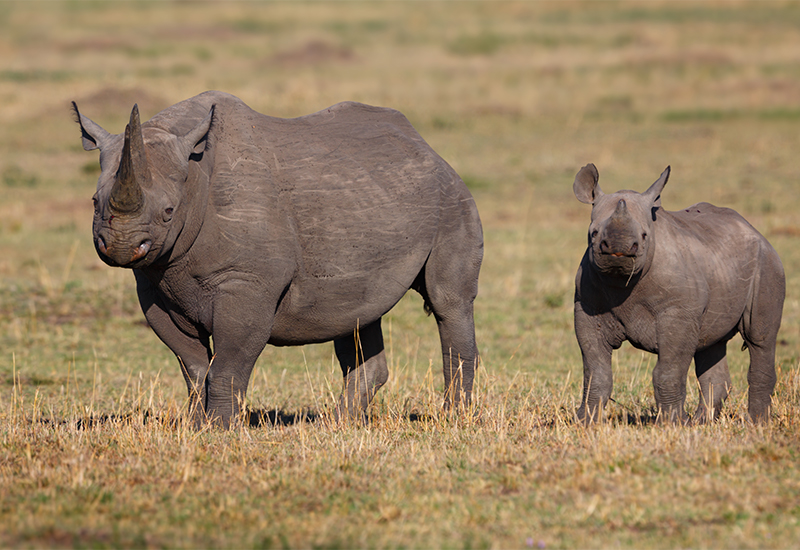
A female black rhino is most dangerous when traveling with a calf and will not hesitate to charge if threatened.Southern white rhinos who were thought to be extinct, now thrive in protected sanctuaries, whilst the western black rhino and northern white rhinos have recently gone extinct in the wild. The only three remaining northern white rhino are kept under 24-hour guard in a Kenyan conservancy.The number of black rhinos has slowly increased over the past two decades but sadly there aren't nearly as many as there once were in the early part of the 20th century. These incredible animals are still under extreme threat due to poaching.
Main Threats
- Poaching for the illegal, international distribution of Rhino Horn
- Habitat Loss due to Lack of Water Sources and degradation
- Hunting by the European settlers in the early 20th Century
- Civil Unrest and War
Best Places to See these Animals
- Ol Pejeta Conservancy, Kenya
- Kruger National Park, South Africa
- Etosha National Park, Namibia
- Phinda Game Reserve, South Africa
- Selous Game Reserve, Tanzania
Did you Know?
Black Rhinos are browsers, getting their nutrition from trees and bushes. They use their squared shaped lips to pluck leaves and fruit from the branches.Black rhinos are the third biggest of the five types of rhino that exist in the world.
Want to learn more about rhino poaching and what is being done to protect these incredible animals?
2. African Penguin
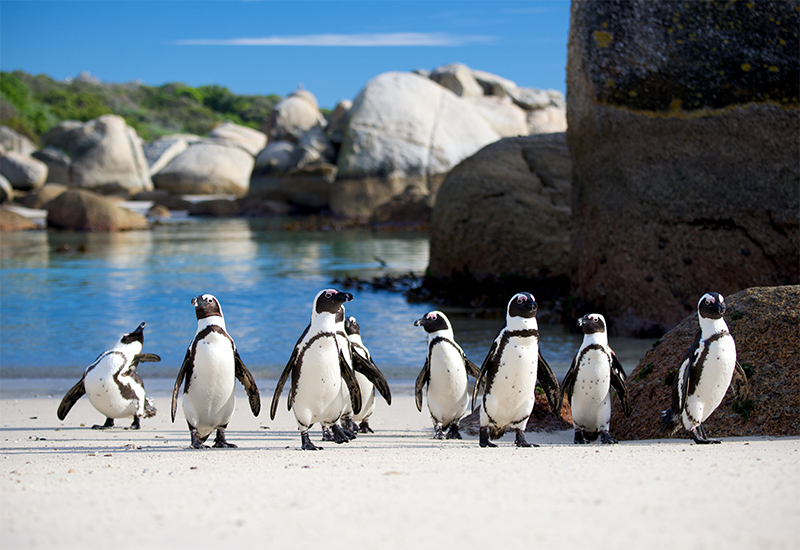
Boulders Beach offers incredible up-close views of the African penguin.Also known as the Jackass Penguin or Black-Footed Penguin is a species found in Southern African Waters. The species is highly charismatic and a popular tourist attraction, however of the 1.5 million estimated in 1910 only 10% remain at the end of the 20th century. With a rapid decline in the population with a current estimation of 95% drop, only about 52,000 mature individuals remain with the Western Cape being home to about 36% of the remaining population. These ancient creatures have been around since 1758, however, if this decline does not decrease the African Penguin is expected to be extinct in the next 15 years.
Main Threats
- Commercial Fisheries
- Environmental Changes Leading to Food Shortages
- Oil Spills
- Shifts in the Sardine and Anchovy Populations
- Human Disturbances
Best Places to See these Animals
- Cape Town, South Africa
- Luderitz, Namibia
- Betty's Bay, South Africa
- Port Elizabeth, South Africa
Did you Know?
African penguins also go by the name of jackass penguins because they make donkey-like braying sounds to communicate.They can dive underwater for up to two and a half minutes while trying to catch small fish.
3. African Wild Dog
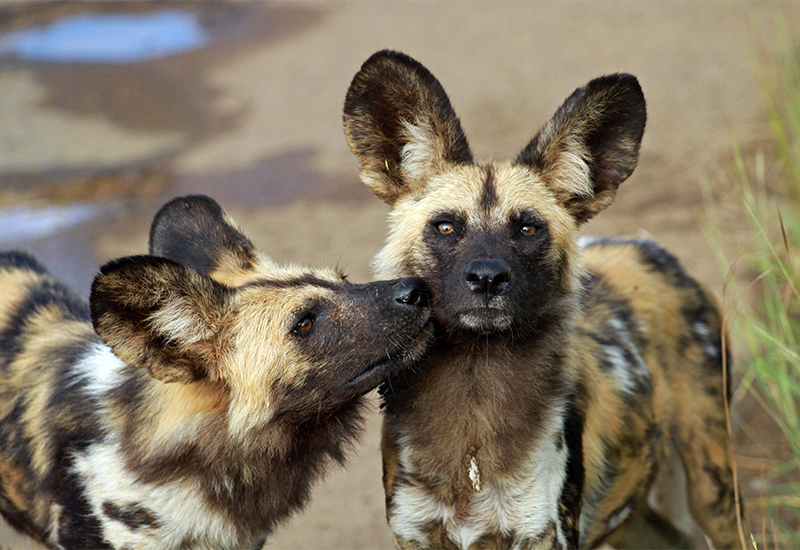
African wild dogs are social animals and are often referred to as the painted wolf.African Wild Dog, or otherwise known as the painted dog or the painted wolf; the mammal of the dog family is native to the Sub-Saharan Africa and the second most endangered carnivore currently in Africa. The Painted Wolf has strong social bonds which result in pack living, usually between 10 and 40. These animals who rely on each other for survival population has fluctuated significantly since 1989 from around 3,000 to 5,500 African Wild Dogs. These acute and determined animals are located in certain regions of Southern African.
Main Threats
- Ongoing Habitat Fragmentation
- Infectious Diseases
- Conflict with Humans
Best Places to See these Animals
- Kruger National Park, South Africa
- Madikwe Game Reserve, South Africa
- Okavango Delta and northern Botswana
- Hluhluwe-iMfolozi Game Reserve, South Africa
Did you Know?
Once the pups reach maturity, it is the males that stay within the pack whilst the females look to join new packs.African wild dogs give birth to their young in underground dens abandoned by warthogs or porcupines.
4. Grevy’s Zebra
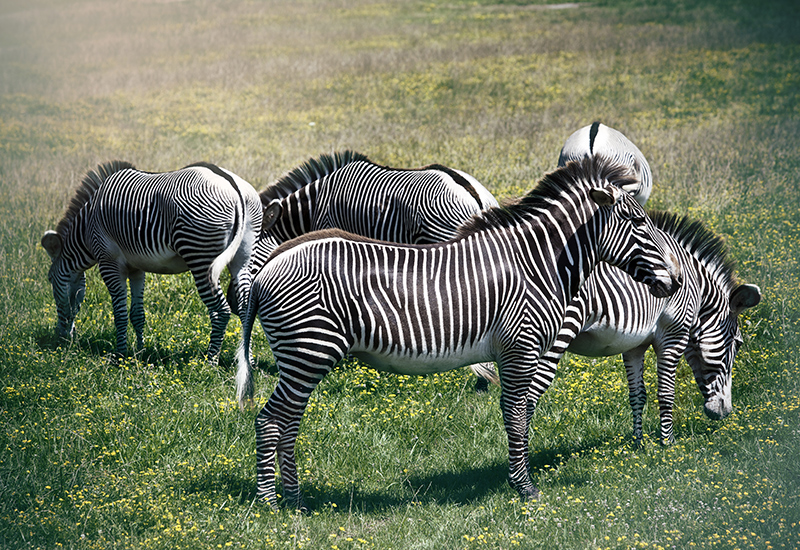
The Grevy's Zebra is in fact black with white stripes.Grevy’s Zebra or otherwise known as the Imperial Zebra, is the largest known surviving Equid and the most threatened of all three species of Zebra. These fast developing, quick learning animals make lifelong social bonds, are predominantly located in Southern Ethiopia and Northern Kenya and have been endangered since 1986 with no more than 2,000 Grevy’s Zebra’s in the world today. These unique looking animals have roamed the world for thousands of years and deserve to be defended and protected as any other living creature who inhabits our planet.
Main Threats
- Hunting for Skin Hyde's
- Reduced Water Sources
- Habitat Degradation due to Competition for Natural Sources
- Diseases
Best Places to See these Animals
- Samburu National Park, Kenya
- Okavango Delta, Botswana
- Tswalu Kalahari, South Africa
- Etosha National Park, Namibia
Did you Know?
Grevy's Zebra don't have any stripes on their belly.The Grevy's Zebra is the largest of all of the wild horses in the world.
5. Pangolins
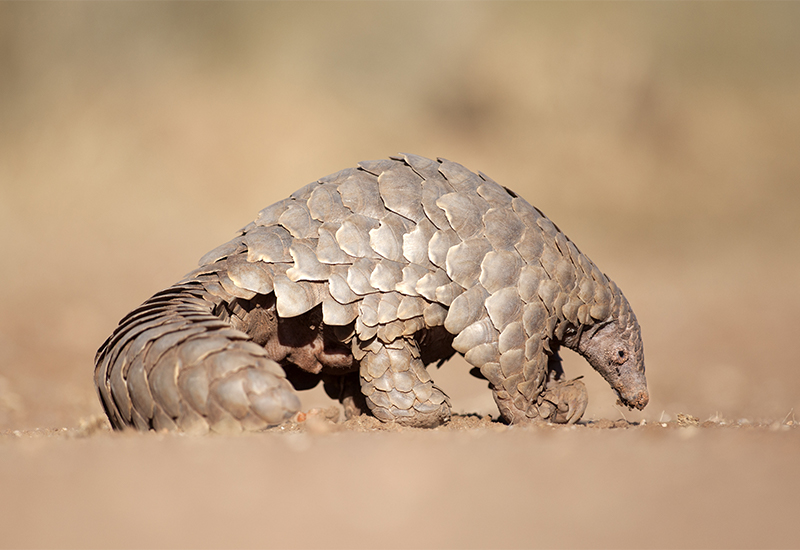
The scales of a pangolin constitute 20% of the pangolins weight and are protect them from predators.Southern Africa is home to the Cape or Temminck’s Ground Pangolin, whilst the Giant ground pangolin, White-bellied or Tree pangolin and the Black-bellied or Long-tailed pangolin are other species found in Africa.The pangolin numbers in Africa are rapidly declining because they are the most trafficked animal on the planet. The estimated number of pangolins trafficked every year is around 10 000.The meat of a pangolin is considered to be a delicacy in China, and the scales of a pangolin are eaten as a treatment for lactation issues, blood circulation problems, and cancer.
Main Threats
- Trafficking
- Illegal Hunting
- Leopards, Wild Dogs, and Pythons
Best Places to See these Animals
- Tswalu Kalahari, South Africa
- Samara Private Game Reserve, South Africa
- Shinde, Botswana
- Namiri Plains, Tanzania
- Madikwe Game Reserve, South Africa
Did you know?
Once the pangolin rolls up into a ball it becomes an impenetrable fortress that even lions and leopards cannot break into.Despite popular belief, the pangolin is closely related to carnivores rather than anteaters.
6. Chimpanzee
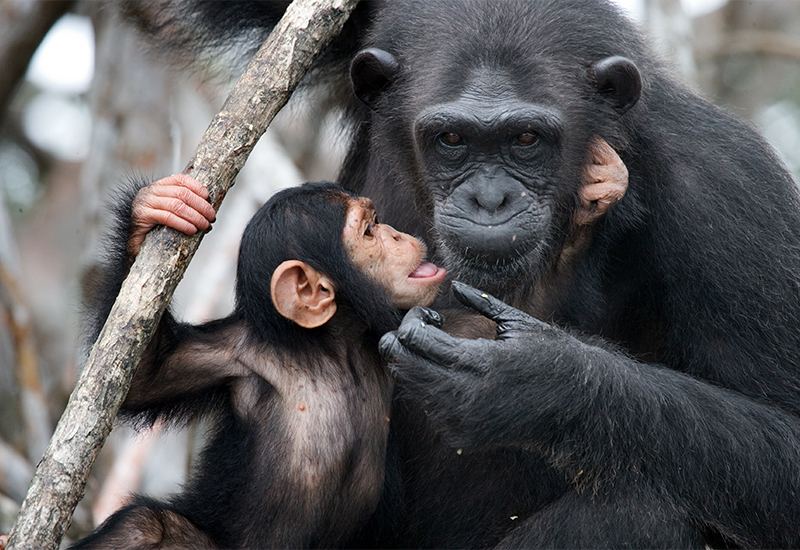
The mother-child bond is one of the most important in a chimpanzee's life.Sharing more than 98% of our genetic blueprint Chimpanzees are our closest living relatives, even sharing a common ancestor said to live some eight billion years ago. Also known as the Robust Chimpanzee this animal is only found in Africa and endangered since 1996, with 170,000-300,000 chimpanzees left and numbers still declining. Bushmeat is a popular source of dietary protein for local communities so the degree of hunting has increased dramatically, and the activity has become heavily commercialized with much more of the meat now going to urban residents. There are a few protected reserves for Chimpanzees with Uganda being the most well-known destination for gorilla and chimpanzee trekking in Africa.
Main Threats
- Poaching
- Destruction and Degradation of Natural Habitats
- Hunting for Bushmeat, Pet Trade, and Traditional Medicine Use
- Infectious Diseases
- Leopards
Best Places to See these Animals
- Gombe National Park, Tanzania
- Jane Goodall Chimpanzee Eden, South Africa
- Mahale Mountains National Park, Tanzania
- Kibale Forest National Park, Uganda
- Nyungwe Forest, Rwanda
Did you Know?
Chimpanzees are omnivores which mean that they eat both plants and animals.Chimpanzees use sticks to retrieve insects, stones to open up nuts, and leaves to soak up drinking water.
7. Cheetah
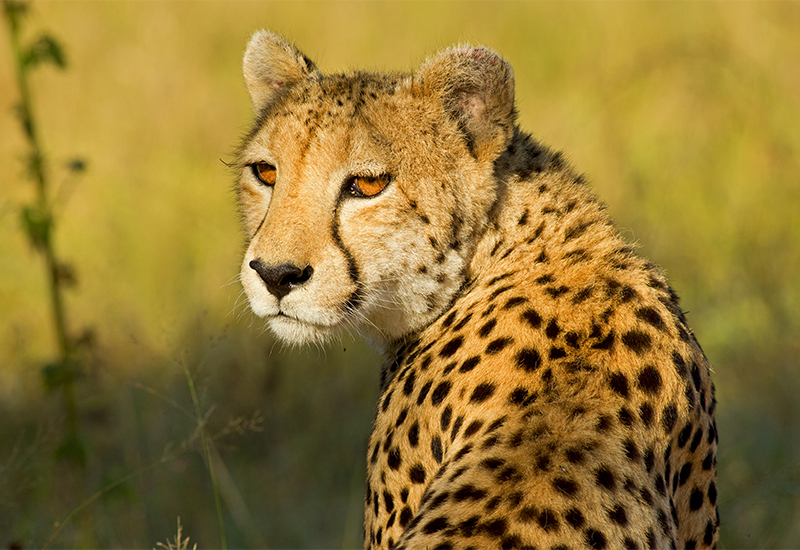
A cheetah can reach a maximum speed of 120km/h in short bursts.The Cheetah is regarded to be the fastest land animal over short distances and can reach speeds of up to 90 kilometers per hour when chasing down its prey. Back in the 1970's, European Settlers considered cheetah to be vermin and needed to be eliminated. With an estimated 6,674 wild cheetahs remaining, the majority are located in Southern and Eastern Africa.
Main Threats
- Human Encroachment
- Habitat Loss
- Illegal Pet Trade
- Large eagles, lions, hyenas, and baboons
Best Places to See these Animals
- Kruger National Park, South Africa
- Phinda Private Game Reserve, South Africa
- Etosha National Park, Namibia
- Masai Mara, Kenya
- Okonjima, Namibia
Did you Know?
Cheetahs can lose about 50 percent of their food to other predators.Males are known to bond and stay together from a young age.
8. Rothschild Giraffe
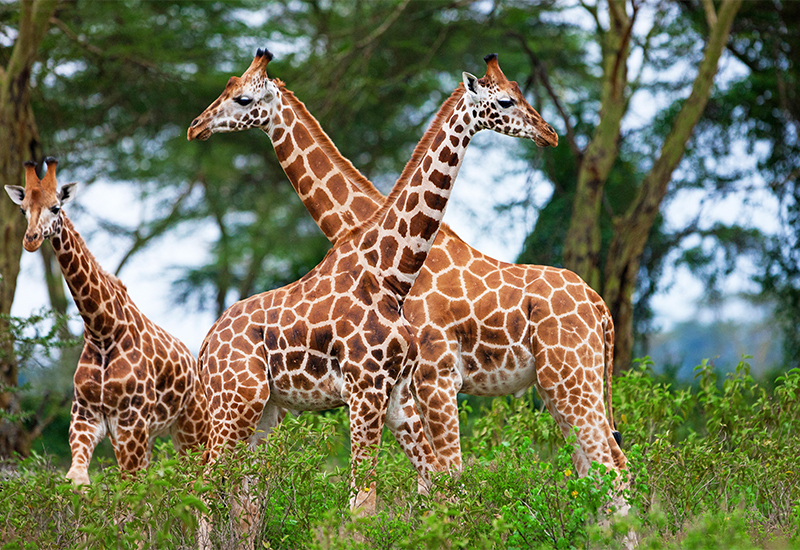
The Rothschild giraffe has a very unique coloring compared to the other species of giraffe.Named after passionate zoologist Lord Walter Rothschild in 1900, who describes the creatures as free-ranging and abundant, however, this is no longer the case, with Rothschilds giraffes being classified as endangered in 2010. With fewer than 670 individuals remaining in the wild and a rapid decrease still in the population, it is important for us to take a stand for these historical and beautiful animals. A Rothschild Giraffe is identified by its lack of markings on the lower part of their legs.Main Threats
- Population Segregation
- Poaching
- Habitat Loss
- Human and Wildlife Clash
Best Places to See these Animals
- Murchison Falls Park, Kidepo Valley Park, and Lake Mburo Park in Uganda
- Nairobi, Kenya
- Lake Nakuru National Park, Kenya
Did you Know?
The Rothschild Giraffe is related to an Okapi - found in the tropical rainforests of the Congo.Female Giraffe bellow when calling their young and males emit loud coughs during courtship.
9. Mountain Gorilla
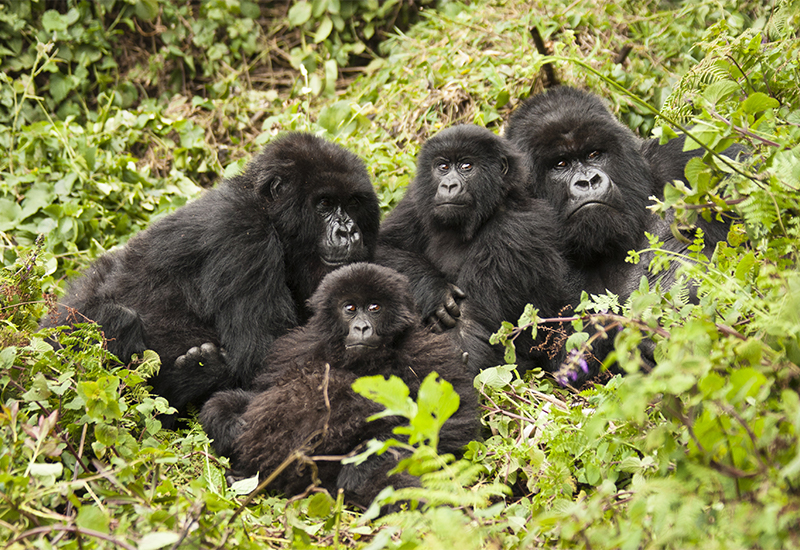
Mountain gorillas are extremely shy but when threatened can become extremely aggressive.Mountain gorillas are one of the most recognized animals in the world and are the largest and rarest primate, weighing in at around 100 kilograms to 194 kilograms. Since their discovery in 1902, the Gorilla population has endured a constellation of grievances such as war, hunting, habitat destruction, and disease. Found in Uganda and Rwanda, there are approximately 1004 individuals alive today. Their extinction was predicted to come near the end of the 20th century due to years of severe threats, however, despite that, they have remained critically endangered since 1996.
Main Threats
- Hunting by Humans
- Poaching
- Habitat Loss and Destruction
- Disease
Best Places to See these Animals
Did you Know?
Gorillas share 98% of human DNA.Female gorillas can start reproducing at the age of 10 and carry one or two babies for a period of eight and a half months.
10. African Elephant
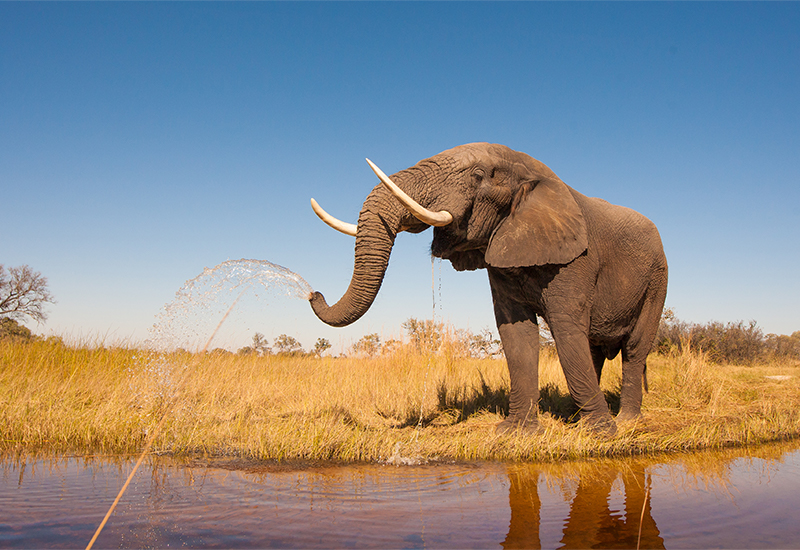
An African elephant can drink up to 189 liters of water a day and consume up to 270 kilograms of food.With the recent rise in poaching for the illegal ivory trade, the African elephant is vulnerable to becoming an endangered species. Ivory is commonly used to manufacture piano and organ keys, billiard balls, handles, and minor objects of decorative value. The demand for ivory is high in China and the Far East because it is used in lots of medicines, ornaments, and jewelry. It is estimated that up to 30,000 African elephants die every year.
Main Threats
- Illegal Ivory Trade
- Habitat Loss
- Pet Trade
Best Places to See these Animals
- Chobe National Park, Botswana
- Addo Elephant Park, South Africa
- Amboseli National Park, Kenya
- Okavango Delta, Botswana
- Damaraland, Namibia
Did you Know?
Baby elephants lose their first set of teeth and tusks just like humans.You can tell by an elephants tusk if they are left or right, with the dominant tusk being shorter.It's our job to ensure the restoration and conservation of these animals so that one day our children's children will get the opportunity to know and love these majestic creatures, that they will roam and inhabit the earth for many many years to come. See and appreciate these animals in their natural habitat today and book your next Safari Adventure with us at Safari.com to see how you can see these make a difference.

